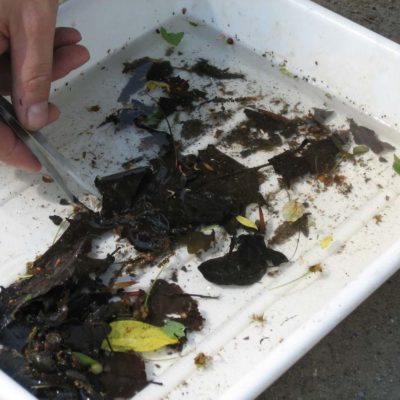are now detected in almost all flowing waters. These are synthetic organic substances that occur in the water body in very low concentrations (ng/L to a few µg/L). They include pharmaceuticals, X-ray contrast media, household chemicals, cosmetic products, biocides and pesticides as well as industrial chemicals.
Micropollutants
The micropollutant loads in flowing waters
are a challenge for current wastewater treatment plants. One of our goals is therefore to investigate the effects of micropollutants on the aquatic biocoenosis by means of monitoring.
Micropollutants
The biotic communities of flowing waters predominantly indicate poor ecological status. The influence of micropollutants is discussed as an important cause in this context, along with structural deficits.
One possible approach to reducing the micropollutant load in running waters caused by sewage treatment plants is to establish an additional purification stage at sewage treatment plants by means of ozonation or activated carbon filtration (so-called fourth purification stage).
Our research approaches lie in
- the application of a monitoring accompanying the measures to evaluate the effects on the aquatic biocoenosis. We investigate the effects on primary producers (macrophytes, phytobenthos) as well as on the macrozoobenthos.
- the targeted investigation of specific effects in specific single-species test procedures. In cooperation with our partners, we use a comprehensive biotest range with organisms of different trophic levels and with acute, chronic or mechanism-specific endpoints.
In Germany,
90.5
of running waters fail to achieve good or very good ecological status (as of 2018), and
100
fail to achieve good chemical status (as of 2018).
References
Projects
2020-2022
Biologisches Monitoring der Wurm im Bereich der Kläranlage Soers: Makrozoobenthos, Makrophyten und Phytobenthos | WVER, Wasserverband Eifel-Rur
2014-2020
DemO3AC - Demonstrationsvorhaben Ozonung des Abwassers auf der Kläranlage Aachen-Soers, Projektteil Statistische Auswertung und biologisches Monitoring | MULNV NRW
Project report2016-2019
NANO-Transfer – Transfer kohlenstoffbasierter Nanomaterialien in der aquatischen Umwelt: Verbleib, Effekte, Bioakkumulation, Nahrungsnetzübertragung, Schadstofftransport und Einsatz in der Remediation belasteter Gewässer. Teilprojekt Forschungsinstitut gaiac – Mesokosmosstudie| BMBF, FKZ 03XP0061C
2014-2017
Nanomobil - Synthetische Silber-Nanopartikel im System Boden-Grundwasser: Mobilität, Wirkungen auf die Lebensgemeinschaft und Wechselwirkung zwischen Hydro-, Pedo- und Biosphäre. Teilprojekt AP 2 Biosphäre | BMBF, FKZ 03X0151A
Project website2016
Korrelationsanalyse von biologischen, chemischen und materialabhängigen Parametern im Rahmen eines Forschungsvorhabens zu Spurenstoffen bei der weitergehenden Abwasserreinigung durch Aktivkohlefilter | IWW, Rheinisch-Westfälisches Institut für Wasserforschung gemeinützige GmbH
2015
Ökotoxikologische Untersuchungen und statistische Auswertung zu Abwasserproben aus verschiedenen Reinigungsstufen einer Kläranlage | Wupperverband
2014-2015
Untersuchung von Abwasserproben aus verschiedenen Reinigungsstufen einer Kläranlage eines Krankenhauses in Dänemark | DHI, Horsholm, Dänemark
2010-2014
Untersuchung von Abwasserproben in biologischen Standard-Testverfahren im Rahmen des Projektes „Metabolitenbildung beim Einsatz von Ozon (EA10)“ | MUNLV, Umweltministerium NRW
2011-2012
PILLS - Pharmazeutische Rückstände in der aquatischen Umwelt - Projektbegleitende Durchführung von Biotests zur Bewertung von Ozonung (EU-Interreg IV Projekt ) | Emschergenossenschaft
2007-2008
Untersuchung von Abwasserproben im Reproduktionstest und im Populationstest mit Daphnia magna zur Behandlung von Krankenhausabwässern in Kooperation mit dem Institut für Siedlungswasserwirtschaft | MUNLV
2005-2006
Testung von Abwasserproben auf endokrines Potential mit dem MVLN-Test | LUA, Landesumweltamt NRW
Publications & Presentations
2020
Brückner, I., Classen, S., Hammers-Wirtz, M., Klaer K., Reichert J., Pinnekamp J. (2020): Tool for selecting indicator substances to evaluate the impact of wastewater treatment plants on receiving water bodies. Science of The Total Environment 745: 140746. DOI: 10.1016/j.scitotenv.2020.140746.
2018
Brückner, I., Stepkes, H., Reichert, J., Kirchner, K., Agler-Rosenbaum, M., Classen, S., Hammers-Wirtz, M., Schiwy, S., Müller, Y., Shuliakevich, A., Hollert, H., Kohlgrüber, V., Klaer, K., Pinnekamp, J. (2018): Abwasserozonung – Evaluierung des Nutzens für die aquatische Umwelt. wwt Modernisierungsreport 2018/2019: 41-44.
2018
Brückner, I., Klaer, K., Schiwy, S., Kirchner, K., Hammers-Wirtz, M., Müller, Y., Shuliakevich, A., Classen, S., Stepkes, H., Grunau, T., Dolny, R., Gebhardt, W., Gschwendtner, R., Montag, D., Könemann, S., Wendt, L., Hollert, H., Agler-Rosenbaum, M., Reichert, J., Pinnekamp, J. (2018): Abschlussbericht der Phase 1 des Forschungsvorhabens De-monstrationsvorhaben Ozonung des Abwassers auf der Kläranlage Aachen-Soers (DemO3AC). Gerichtet an das MULNV NRW. Düren, 2018.
2014
Schmidt, T. C., Kowal, S., Börgers, A., Dopp, E., Erger, C., Gebhardt, W., Gehrmann, L., Hammers-Wirtz, M., Herbst, H., Kasper-Sonnenberg, M., Linnemann, V., Lutze, H., Lyko, S., Magdeburg, A., Maus, C., Portner, C., Richard, J., Türk, J. (2014): Abschlussbericht zum Forschungsvorhaben „Metabolitenbildung beim Einsatz von Ozon" – Phase 2: gerichtet an das Ministerium für Klimaschutz, Umwelt, Landwirtschaft, Natur- und Verbraucherschutz des Landes Nordrhein-Westfalen (MKULNV), AZ IV-7-042 600 001J, Vergabenummer 08/058.1.
Project report2013
Hammers-Wirtz, M., Magdeburg, A., Lyko, S., Nafo, I. (2013): Occurrence, alteration and reduction of ecotoxicological effects of hospital wastewater from different advanced treatment. Poster presentation, SETAC Europe 23rd Annual Meeting, 12-16 May 2013, Glasgow, Scotland.
Poster2013






